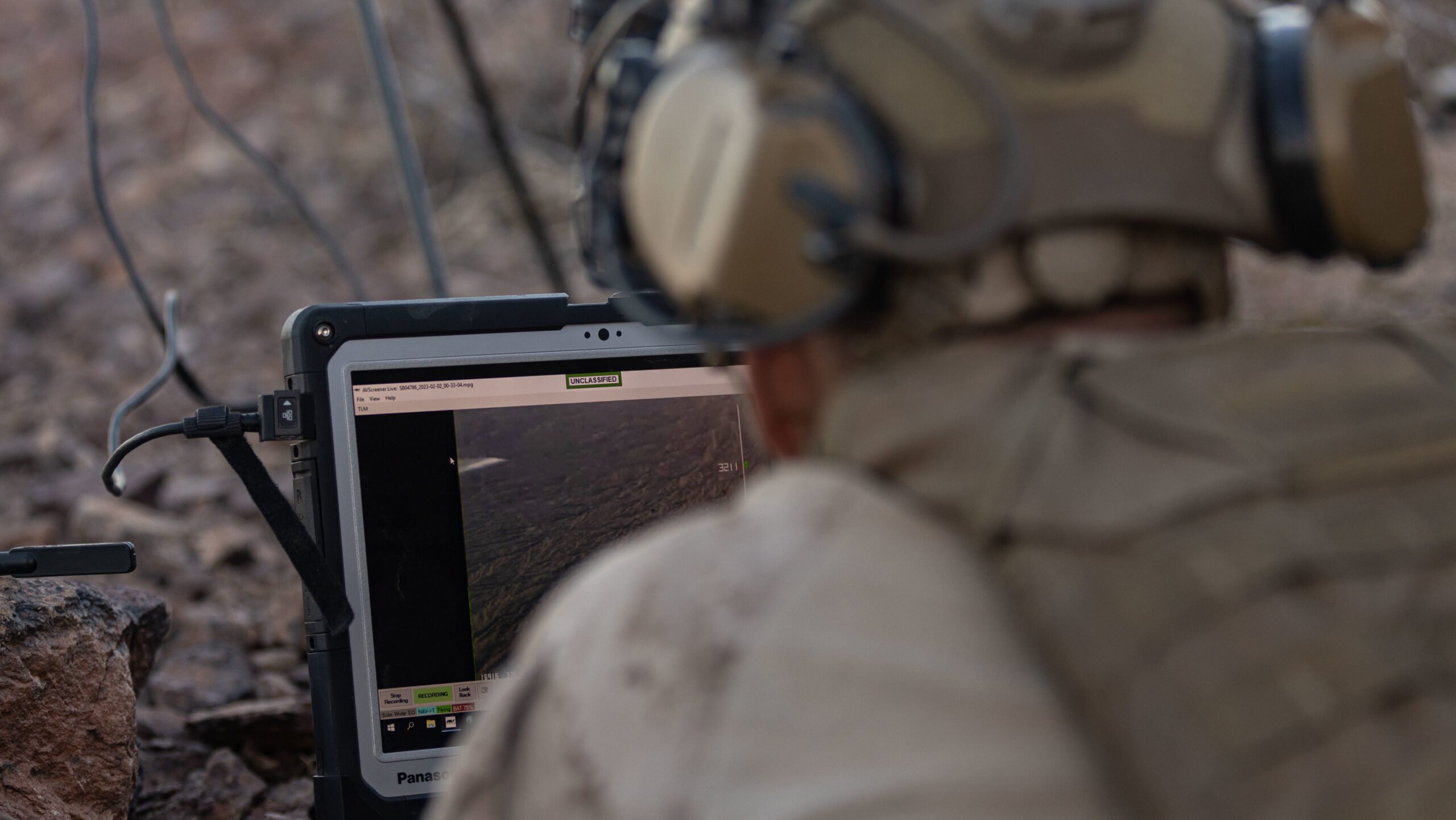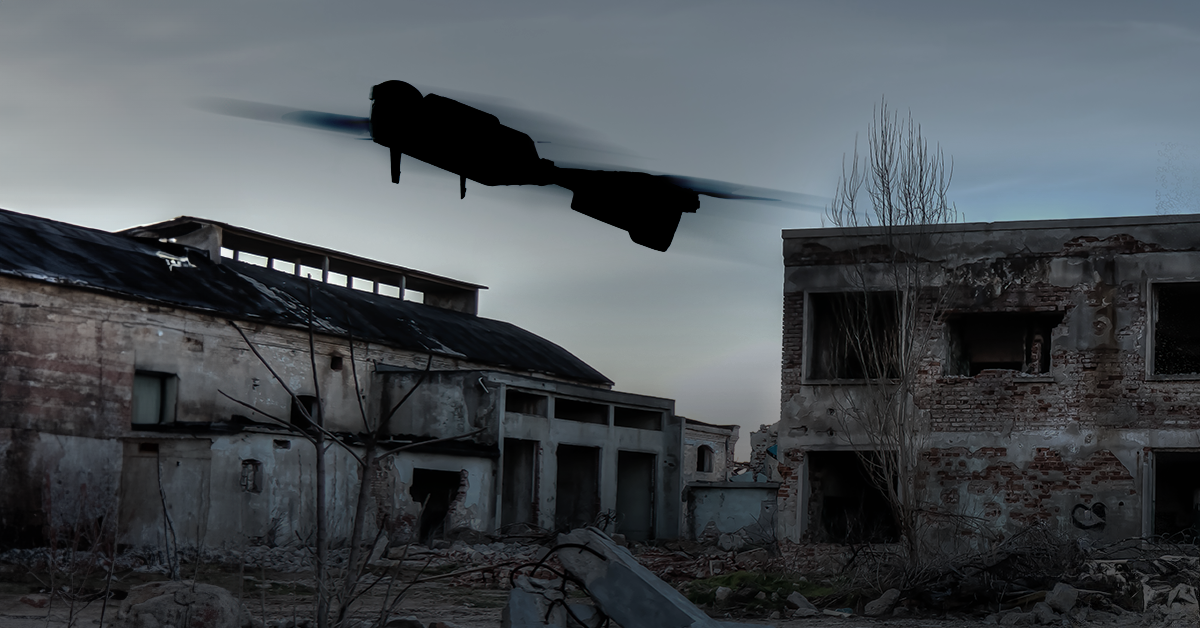
A Reconnaissance Marine with Company C, 1st Reconnaissance Battalion, 1st Marine Division, monitors the visual feed from a Switchblade 300 during the Ground Reconnaissance Course (GRC) at Camp Wilson on Marine Corps Air Ground Combat Center, Twentynine Palms, California, Feb. 1, 2023. (U.S. Marine Corps photo by Lance Cpl. Anna Higman)
MODERN DAY MARINE 2024 — With one-way drones becoming a regular sight on battlefields worldwide, the US Marines this month took a big step towards matching that capability.
On April 11, US Marine Corps Systems Command (MARCORSYSCOM) signed agreements with Aerovironment, Anduril Industries and Teledyne FLIR to support the roll out of the Organic Precision Fires-Light (OPF-L) System Development Contract.
Very little information was disclosed by USMC regarding the types of loitering munitions being considered as part of the OPF-L development contract. But there is a trail of breadcrumbs that leads to the conclusion that the Marines are purposefully keeping as many options on the table. As a result, two of the vendors are providing vertical take-off/launch (VTOL) solutions, while the third is going for a fixed-wing solution.
“[We] see the VTOL and fixed wing loitering munitions as complementary capabilities to one another,” a MARCORSYSCOM spokesperson told Breaking Defense.
“The Marine Corps will make a determination based on the technical maturity of the systems provided by each vendor. There is no downselect planned for OPF-L. All three vendor systems may be fielded if they successfully complete performance testing and meet certification requirements,” the spokesperson said, adding that the Marines want to see “non-developmental, loitering munition systems for qualification and performance testing in FY24 and FY25.”
Worth up to $249 million, the OPF-L program is scheduled to run up to eight years and will include the “build, test, support and delivery of a non-developmental item loitering munition system designed to provide dismounted marines in the infantry rifle squad with precision strike capability against adversaries beyond the line of sight,” according to the original solicitation published by the Department of Defense in September 2023.
“The Organic Precision Fires-Light system should be man-packable and consist of the loitering munition, related ground control station, training simulator and ancillary equipment needed to support the technology,” the solicitation added.
Additional details provided by the government in the Q&A section of the solicitation process confirmed recoverability of the loitering munitions should be “mission-based” instead of “time-based.” Documents also confirmed there is no maximum time requirement between recovery and relaunch of loitering munitions.
Furthermore, the government asked providers to illustrate how loitering munitions could select a safe “ditch location” to crash or land if parameters are met, and it also suggested OPF-L solutions should be capable of being operated from “navy facilities, ships and aircraft” although no specific platforms were mentioned.
The solicitation demanded additional information regarding the ability of operators to “recover” loitering munition systems from electromagnetic spectrum attacks.
The spokesperson said the command saw it as “beneficial to be able to safely recover and reuse the OPF-L munition,” although this was “not critical” to the program.
Finally, the spokesperson confirmed OPF-L munitions would be equipped with “kinetic” payloads although there is no specific requirement for these to be included in the test and evaluation stage of the program.
Selected Solutions
Aerovironment, Anduril and Teledyne FLIR remain tight lipped about their OPF-L offerings. However, company officials did confirm certain additional details to Breaking Defense.
Teledyne FLIR confirmed in a statement it had been awarded an initial $12 million by the USMC for the first phase of the OFP-L program, which will see it deliver 127 loitering munition systems for test and evaluation “later this summer.” The company’s submission comprises a “new quadcopter design,” specifically designed to be “recoverable and reusable” should operators fail to engage a target during a mission, according to the statement.
“Teledyne FLIR’s advanced small, vertical take-off and landing (VTOL) loitering munition solution has proven highly successful in tests against both moving and stationary armor, vehicles, and dismounted targets,” a company spokesperson said. “The ability to recover and reuse the new system will lighten the pack load for Marines while increasing their warfighting effectiveness.”

Teledyne Flir’s concept art for its OPF-L offering. (teledyne Flir)
Teledyne FLIR has also published an artist’s impression of its new solution, which shows the VTOL solution conducting low altitude flight through an urban environment. Dave Viens, the company’s vice president of business development-US, told Breaking Defense the solution was designed to allow small unit teams to dominate the “Atmospheric Littoral”- the “low altitude and unobstructed airspace where systems can move freely at the tactical edge and provide a new dimension on the battlefield.”
Anduril Industries also went with a VTOL solution, with a company official confirming to Breaking Defense that it comprises a quadrotor design which includes a series of “proven” technologies and capabilities such as “safe return-to-base capability; advanced tracking and guidance systems; and optimized terminal engagement to increase effectiveness and reduce cognitive burden in dynamic tactical environments.”
Development of a VTOL loitering munition system marks a significant new direction for Anduril, which has previously developed fixed-wing solutions based on the Altius uncrewed aerial system (UAS). The Altius 700, equipped with a 30lb kinetic payload, was previously selected by the US Special Operations Command as part of the Maritime Precision Engagement-Munition (MPE-M) program.
Finally, Aerovironment will provide a fixed wing capability to the OPF-L program, supplying an undisclosed number of Switchblade 300 Block 20 loitering munitions, which are already in service with the US Army. SB300s will provide an alternative concept of operation for Marines in comparison to the other two firms’ VTOL solutions.
Unveiled in March 2023, the Block 20 is the latest variant of the SB300 which the company claims features enhanced armor penetration, increased target attack angle, as well as extended battery life, flight endurance and range.
Speaking to Breaking Defense, a company official confirmed Aerovironment was “ready to produce and deliver the initial order under the contract and have the capacity to support future orders through additional phases of the program.”
“Switchblade 300 is a tube-launched aerial loitering munition, allowing it to pursue a different and broader target set. With certain payloads, it has the ability to go after both static and moving targets BLOS. It would be up to the USMC’s acquisition strategy to determine the appropriate mix between quad and fixed wing solutions for the program,” the official concluded.






















